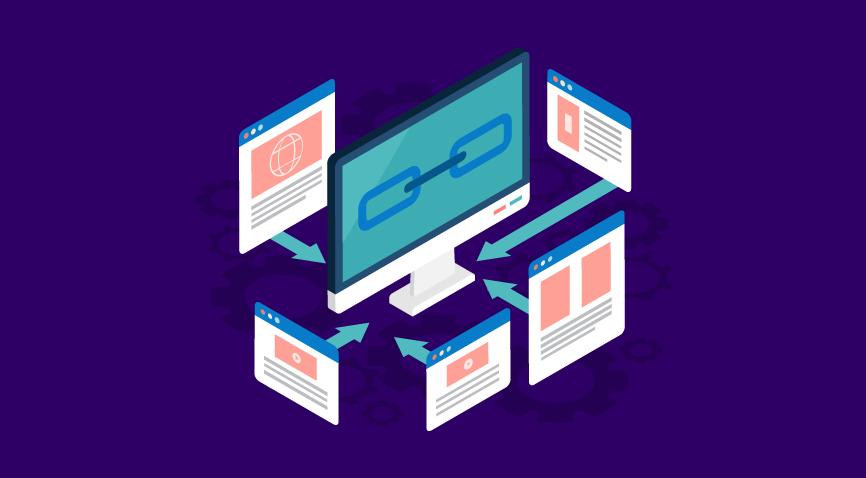What is Internal Linking for SEO and How to Leverage It

Table of Contents
- Introduction
- What is Internal linking?
- Why is Internal linking Important?
- How to create an Internal linking Strategy
- How to Use Internal links For SEO
- Conclusion
- FAQs
If you’ve written an engaging blog post, you’ll want to make sure it gets as much attention as possible. Your SEO strategy should include high-quality content and inbound links. Knowing how the pages on your website to one another should always be part of that strategy. In this post, we will cover what internal linking is, its importance for SEO, useful internal linking tips, and much more.
What is Internal linking?
When you use hyperlinks to connect one page of your website to another, you’re doing internal linking. In addition to boosting your SEO authority, this strategy can help keep visitors on your site for extended periods of time. Ranking for really difficult keyword phrases is much simpler with outstanding internal linking because you can share some of your finest content within your own website.
What is an internal link? An internal link takes you to a page on the same website. Internal links are most typically used for navigation, but they have now evolved to improve search engine rankings as well. Search engines use the concept of link equity, or ranking power, to rank websites. In the early 1990s, Google created a specific PageRank algorithm to determine how authoritative a page is. Google values pages with more backlinks. Because of this, adding links to a certain page boosts its link equity and improves its search engine rankings. Using good internal links has the following benefits:
- Internal link anchor text improves usability.
- Internal links boost page rank and page views.
- Internal links reduce bounce rates.
- Internal linking increases your site’s indexing.
External linking, on the other hand, encourages your clients to click on links that would take them away from your website. This is, however, a vital part of SEO. External links help improve user experience, pass SEO authority to another domain, and boost your website’s reputation. It is an effective technique to raise the overall quality of your website’s pages. Here are a few benefits of using good external links:
- An external link may be beneficial to your readers.
- A good external link can help your website gain authority.
- External links help elevate relevance.
- External links assist in increasing credibility.

Why Is Internal linking Important?
For Google and other search engines, using internal linking is an essential exercise. Search engines employ links to discover new information on websites and rank it in their results. Having a considerable number of links to your post or page tells Google that you have written something of importance or value. This includes both internal and external links. But the major difference between the two is that you control internal links as the site owner. Through these links, you can guide users and search engines to discover your content.
Googlebot uses both internal and external links to examine web pages. This bot goes to a website’s main page, renders it, and chooses the first link. Google can figure out the relationship between pages, posts, and other content by following internal links. This exercise helps the bot find similar pages on your website. If a website with higher authority links to your web page, Google will consider your site more credible and reliable. This is how your page’s link value increases. Similarly, certain pages from your website may have more link value than others. As a result, linking to new entries from those pages can be more beneficial for your website. A post’s value increases as more people link to it. Because Google considers a page with many links valuable, it will rank higher. So by two linking two pages on the same website, you can enable a transfer of PageRank value.
How to create an internal linking strategy
You need to factor in many things to create a successful internal linking strategy. Here are a few internal linking tips to boost your website’s ranking:
1. Refine your content
You must choose your most vital content and update it. Make sure it is relevant to your industry and answers some pressing questions your users might have. People seeking information about particular topics should find this content helpful. In other words, every piece of content that you put out should be rife with value and meaning.
You will need a lot of internal links to inform Google that certain pieces of content on your site are of the highest value. Since you will need a lot of internal pages, it is also a good idea to build on and rehash your existing content to suit the needs of your target audience. You can add internal links to premium content from multiple locations.
2. Audit existing internal links
If you want to build an internal linking strategy for an existing website, then it is wise to perform an audit of its old internal links. This step will help you in gauging the strength and quality of your existing internal links before you go on to add new ones. For larger sites, a dedicated AI internal linking tool such as Linkter can crawl every page, surface high-value contextual link opportunities, and even publish the updates in bulk – saving you hours of manual work and ensuring no important pages are missed.
3. Use contextual links
Contextual links are essentially deep links that are present within your web content. Include links to articles that are similar. This will demonstrate to Google that the two posts are related. This activity can help garner greater link value and higher ranking for your website. You can use contextual links either between sentences or at the end of the content piece.
Remember that the context against which you are linking the two pages should be clear and relevant. For example, if you have two pages about restaurants and farming equipment respectively, linking them is a poor idea, as both are wholly different topics.

4. Consider including navigational links
In addition to linking from related posts and pages, you can link to your cornerstone content from the homepage or top navigation bar. However, you should use this method sparingly; ensure that you apply this technique to only those articles that are highly crucial to your business. This is because links from topically relevant pages are far better than those from places such as the homepage, which are inundated with content and links.
5. Include links to popular posts
Create internal links to your website’s most-read or favored content. In order to have these sections displayed on all of your website’s pages, you can add them to the sidebar or footer of your website. Since users can discover and access popular posts more easily, they can help drive more traffic to your site.
How to use internal links for SEO?
When devising an internal linking strategy, here are a few tips to ensure that you’re making the best use of your internal pages’ authority.
1. Make a comprehensive map of your website
Generate a list of all the pages on your website and the links to each of them. It will assist you in understanding the existing links between each area of your site and how you’ve previously linked them together. Visually laying out your entire website is often the only way to see what you’ve missed and what’s working out. You might discover that some of your top pages are performing high because you did a terrific job writing that particular piece of content.
2. Analyze the topics on which you usually write
If you write about a topic regularly, you should have a dedicated page on your website for it, such as a landing page with an offer. Those postings should include a link to the authoritative web page on the issue, which should be conversion-optimized. Internal linking and a strong call-to-action (CTA) on your landing page can aid in the generation of new leads for your offer. You should also determine where that page fits on the website and whether your homepage or products page should link to it. In some industries, a direct link to a specific blog post or page from the main navigation menu might be useful.
3. Don’t overdo it
It is easy to fall into this trap. We all want to reduce bounce rates, increase conversions, and pass as much link value as possible. More content means more opportunities to link to it. But you must limit yourself. Too many internal links degrade your web page’s rank and make your content appear spammy. Furthermore, consumers may feel overwhelmed and end up not clicking on anything.
4. Use silo structures
Some well-known SEO experts advise siloing or linking just inside a specific category or topic group. This strategy focuses on topical importance within a group of URLs. Demarcating certain topics or content groups makes it easier for the search engine to crawl through web pages. Since silos help you organize your website into topics and subtopics, it will help make your website look topically relevant to Google.

Don’t pack your navigation and footer with links<h3>
Although this is more about enhancing user experience (UX) than rankings, UX and SEO are becoming more and more integrated. Navigation bars with hundreds of subcategories frustrate customers. Furthermore, Google will have difficulty determining the objective of your website. Make sure your main navigation bar is clean and contains internal links to only your most important pages.
5. Use simple internal linking formulas
We have seen some incredibly complicated PageRank-sculpting algorithms. Those models are outdated ranking concepts. They’re not in line with Google’s current recommendations, which implies that they’re unsustainable.
6. Avoid repeating anchor text
Using the same anchor text on multiple pages is an issue that is more common than you might think. Also, stuffing anchor text with keywords can prove to be damaging for your site. While using exact match anchors for internal links is standard practice, trying to over-optimize it will do more harm than good.
7. Don’t waste link juice
Do you know which of your website’s URLs have the greatest page authority (PA) or URL rating (UR)? Link juice is the amount of positive ranking one page passes to another when linking to it. Make sure to evenly construct links to target pages. Check your top linked pages at least quarterly, and weed out all the links you may have used for low-value pages. You can save on link juice in this manner.
Conclusion
We hope this blog helped you answer the question, “What is internal linking?” Whether your content is fresh or old, a robust internal linking strategy may help it rank higher on Google. Keep in mind that it doesn’t have to be a complicated strategy, because, unlike in external linking, you have complete control over every stage of the process. You can intuitively roll out a strategy that can yield positive outcomes with the correct data, tools, and planning.

FAQs
An internal link connects two pages on the same website. Internal links help transfer PageRank value via anchor text and surrounding content.
Internal links are important, as they assist Google in better understanding and ranking your website. Links with descriptive anchor text are a great way to inform Google which pages on your site are most important and what they’re about. Internal links are also crucial to user experience, and they help increase engagement.
There is no definitive way to know how many internal links are too many. In practice, having too many links on a website isn’t necessarily helpful for the users. Keeping the number of links per page to a moderate level is a sound choice.
Finding relevant pages on your site and linking to them with descriptive anchor text is an excellent way to create internal linking opportunities.
Internal links are hyperlinks that connect one page to another within the same website. For instance, you have a web page that talks about coffee and its benefits. In the same post, you can include a link to another page that may be talking about other aspects of coffee (such as tips to buy a good coffee machine, pros and cons of coffee, history of coffee, etc.) Always make sure that the content is highly relevant to the post you choose to link from.
Latest Blogs
Explore how Google’s 2025 AI search updates triggered ranking chaos. Learn actionable strategies to adapt your SEO for AI Overviews, zero-click searches, and SERP volatility. Stay ahead now.
Learn how to rank on AI search engines like ChatGPT, Perplexity, and Gemini by optimizing your content for authority, structure, and relevance. Stay ahead in AI-driven search with this strategic guide.
Explore the best healthcare SEO services for your medical practice. Improve online visibility and effectively reach more patients in need of your services.
Get your hands on the latest news!
Similar Posts

Artificial Intelligence
6 mins read
The Role of AI in Digital Marketing: AI Article Generators Transforming Content Creation

Artificial Intelligence
4 mins read
How AI Content Creator Is Shaping the Future of Digital Content

Digital Marketing
3 mins read